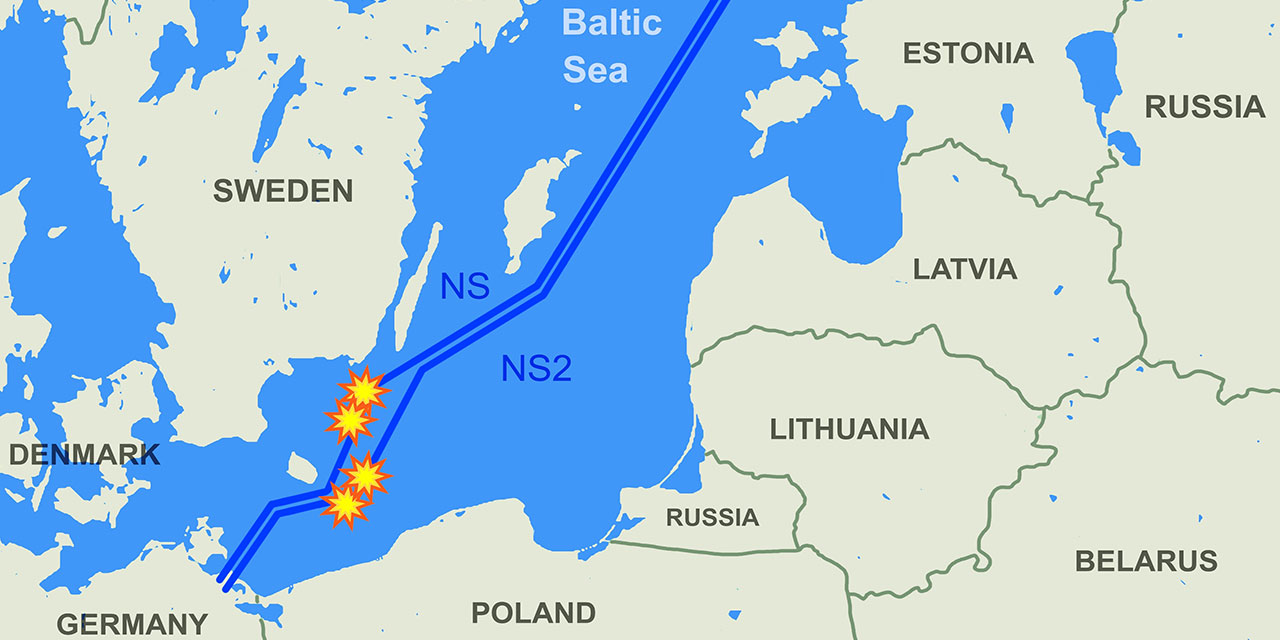
What is the Nord Stream Pipeline? The Nord Stream Pipeline is a massive network of offshore natural gas pipelines that stretches from Russia to Germany under the Baltic Sea. Spanning 1,224 kilometers, it’s one of the longest subsea pipelines globally. This pipeline is crucial for transporting natural gas directly to Western Europe, boasting a combined capacity of 55 billion cubic meters annually. Owned by Nord Stream AG, a consortium led by Gazprom, it has sparked significant geopolitical debate. Critics argue it increases Europe’s dependence on Russian energy, while supporters see it as a reliable energy source. Let's explore 40 key facts about this controversial pipeline.
Key Takeaways:
- The Nord Stream pipeline is a massive infrastructure project connecting Russia to Germany, supplying 55 billion cubic meters of natural gas annually. It has geopolitical implications and has faced controversies and security challenges.
- Despite being crucial for Europe's energy security, the Nord Stream pipeline has raised environmental concerns and geopolitical risks. Its future prospects depend on ongoing assessments and geopolitical developments.
The Nord Stream Pipeline: An Overview
The Nord Stream pipeline is a massive infrastructure project that has significant implications for Europe's energy landscape. It connects Russia to Germany, running under the Baltic Sea, and plays a crucial role in supplying natural gas to Western Europe. Here are 40 key facts about this monumental pipeline.
-
Location and Route
The Nord Stream pipeline stretches from Vyborg, Russia, to Greifswald, Germany. Covering 1,224 kilometers (759 miles), it is one of the longest subsea pipelines globally. -
Capacity
The pipeline can transport 55 billion cubic meters (bcm) of natural gas annually. Each of its two parallel lines can handle 27.5 bcm per year. -
Ownership and Operation
Nord Stream AG, a consortium of five energy companies, owns and operates the pipeline. Gazprom International Projects North 1 LLC holds a 51% stake, while Wintershall Dea AG and PEG Infrastruktur AG each own 15.5%. N.V. Nederlandse Gasunie and ENGIE each have 9%. -
Construction Timeline
Construction of the first line began in April 2010 and finished in June 2011. The second line was laid in May 2011 and inaugurated on October 8, 2012. -
Environmental Impact Assessment
Rambøll conducted the environmental impact assessment, ensuring the pipeline's construction and operation would be safe and environmentally sound. The assessment monitored 16 parameters, including water quality and seabed sediment. -
Safety Measures
The pipeline uses advanced technology to meet international safety standards. It is designed to withstand adverse weather conditions and features sophisticated monitoring systems.
Geopolitical and Economic Implications
The Nord Stream pipeline is not just an engineering marvel; it also has significant geopolitical and economic ramifications. Here are some key points to consider.
-
Geopolitical Significance
The pipeline is controversial due to its geopolitical implications. Critics argue it strengthens Russia's influence over European energy markets, potentially undermining EU strategic autonomy. -
EU Dependence on Russian Gas
The European Union relies heavily on Russian gas imports. As coal is phased out and renewable energy is not yet fully ready, natural gas remains a key part of the energy mix. -
Renewable Energy Transition
While the Green Deal aims for a carbon-neutral Europe by 2050, natural gas will continue to play a significant role during the transition period. Renewable energy sources are expected to gradually replace gas in the long term. -
Domestic Gas Production Decline
EU domestic gas production is declining, and there is not enough affordable gas from alternative suppliers to replace Russian production. -
Nord Stream 1 and 2
The Nord Stream pipeline consists of two separate projects: Nord Stream 1 and Nord Stream 2. Both pipelines each have two parallel lines, NS1 A and B, and NS2 A and B, for a total of four physical pipes. -
Nord Stream 1 Operation
Nord Stream 1 began operations in 2011 and was initially successful in supplying natural gas directly to Western Europe. However, from August 31, 2022, Gazprom halted deliveries indefinitely due to maintenance.
Political Tensions and Controversies
The Nord Stream pipeline has been a focal point of political tensions and controversies. Here are some key facts that highlight these issues.
-
Nord Stream 2 Construction
Nord Stream 2 was built to increase gas exports to Europe, aiming to double the annual capacity. The project was completed in 2021 but did not enter service due to Germany withholding opening permission following Russia's recognition of Ukrainian separatist regions. -
US Sanctions
The United States imposed sanctions on companies involved in the Nord Stream 2 project, citing concerns about increased German dependence on Russian energy. German politicians criticized these sanctions as serious interference in internal affairs. -
Political Tensions
Several EU Member States and Ukraine opposed the project from the start, viewing it as a Kremlin initiative to export malign Russian influence and gas to Europe. This opposition led to significant political tensions between Russia and Western countries. -
Economic Aspects
Proponents argue that Nord Stream 2 is a viable commercial project, providing reliable and cheap energy to the EU. However, opponents see it as fundamentally incompatible with EU energy legislation and policy. -
Environmental Impact
Critics argue that the pipeline's construction has significant environmental impacts, including potential harm to marine life and ecosystems. However, ongoing monitoring has shown that the environmental impact is within pre-construction impact assessments. -
Route Crossing
The pipeline route crosses the Exclusive Economic Zones of Russia, Finland, Sweden, Denmark, and Germany, as well as the territorial waters of these countries. This complex route required careful planning and execution.
Technical and Operational Details
Understanding the technical and operational aspects of the Nord Stream pipeline provides insight into its complexity and scale. Here are some key details.
-
Bovanenkovo Oil and Gas Field
The main natural gas base for the Nord Stream pipeline is the Bovanenkovo oil and gas condensate deposit in Western Siberia. This field has estimated gas reserves of 4.9 trillion cubic meters, making it a reliable source of natural gas for Europe. -
Gazprom's Role
Gazprom, a Russian state-controlled company, holds a 51% stake in Nord Stream AG. This significant ownership gives Gazprom considerable control over the pipeline's operations and decision-making processes. -
Investment and Financing
The construction of the Nord Stream pipeline required a significant investment of 7.4 billion euros. The five shareholders provided 30% of the investment, while the remaining 70% came from commercial loans on international financial markets. -
Logistics Concept
Nord Stream's logistics concept enabled the efficient and environmentally sound production and supply of materials to pipe-laying vessels. This included the use of 202,000 24-tonne concrete blocks to ensure safe and stable pipeline construction. -
Monitoring Activities
By 2016, a total of 40 million euros had been invested in monitoring activities. Approximately 1,000 survey locations measured 16 parameters, including physical and chemical environment, biological environment, and socio-economic environment. -
Pre-Construction EIAs
The environmental impact assessments (EIAs) conducted before construction showed that the pipeline's impacts would be minimal. However, ongoing monitoring has revealed that some impacts are even less than initially assessed.
Public Perception and Future Prospects
Public perception and future prospects of the Nord Stream pipeline are crucial for understanding its long-term impact. Here are some key points.
-
Public Perception
The public perception of the Nord Stream pipeline is highly polarized. Proponents see it as a reliable source of energy, while opponents view it as environmentally harmful and geopolitically risky. -
EU Position
The European Union has taken a nuanced stance on the Nord Stream pipeline. While recognizing its economic benefits, the EU has also expressed concerns about its geopolitical implications and environmental impact. -
US Position
The United States has been a vocal opponent of the Nord Stream 2 project. The U.S. imposed sanctions on companies involved in the project, citing concerns about increased German dependence on Russian energy. -
German Position
Germany has been a key player in the Nord Stream 2 project. The German government initially supported the project but later withheld opening permission due to Russia's recognition of Ukrainian separatist regions. -
Ukrainian Position
Ukraine has been strongly opposed to the Nord Stream 2 project. Ukraine sees the pipeline as a threat to its economy, as it would reduce transit fee revenue from Russian gas passing through Ukraine.
Sabotage and Security Concerns
The Nord Stream pipeline has faced security challenges, including sabotage. Here are some key facts about these incidents.
-
Sabotage Incident
On September 26, 2022, four explosions damaged three of the four Nord Stream pipelines, rendering them inoperable. Investigations by Germany, Sweden, and Denmark are ongoing, with German authorities issuing an arrest warrant for a Ukrainian national suspected of sabotage. -
Pressurized Gas Release
Although none of the four Nord Stream pipelines were in operation at the time of the sabotage, they still contained pressurized natural gas. Vast quantities were released into the Baltic Sea, causing environmental concerns. -
Investigations and Findings
Three separate investigations were conducted by Germany, Sweden, and Denmark. While the Danish and Swedish investigations were closed without publicly assigned responsibility, German authorities continue to investigate the incident. -
Arrest Warrant
In June 2024, German authorities issued an arrest warrant for a Ukrainian national suspected of the sabotage. This development highlights the ongoing geopolitical tensions surrounding the Nord Stream pipeline.
Energy Security and Environmental Concerns
The Nord Stream pipeline plays a crucial role in Europe's energy security but also raises environmental concerns. Here are some key points.
-
Energy Security
The Nord Stream pipeline is crucial for Europe's energy security. It provides a reliable and direct link between Russia's vast gas reserves and European energy markets, ensuring a steady supply of natural gas. -
Commercial Benefits
Proponents argue that the Nord Stream pipeline offers significant commercial benefits, including providing cheap and reliable energy to European consumers. However, opponents dispute these claims, citing the long-term costs and risks associated with fossil fuel imports. -
Environmental Concerns
Critics argue that the pipeline's construction and operation pose significant environmental risks, including potential harm to marine life and ecosystems. Ongoing monitoring has shown that these impacts are generally within pre-construction impact assessments. -
Geopolitical Risks
The Nord Stream pipeline is seen as a geopolitical risk by many. Critics argue that it strengthens Russia's influence over European energy markets, potentially undermining EU strategic autonomy and compromising European strategic autonomy. -
EU Legislation and Policy
The Nord Stream pipeline is fundamentally incompatible with EU energy legislation and policy, according to opponents. They argue that it contradicts the EU's climate goals and long-term investments in renewable energy sources. -
Future Prospects
Despite the challenges and controversies surrounding the Nord Stream pipeline, it remains a critical component of Europe's energy infrastructure. Future prospects for the pipeline depend on geopolitical developments and ongoing environmental and economic assessments. -
Conclusion
The Nord Stream pipeline is a complex and multifaceted project that has garnered significant attention due to its economic, environmental, and geopolitical implications. Understanding these 40 facts provides a comprehensive overview of the pipeline's history, operation, and impact on European energy security and global politics.
The Nord Stream Pipeline's Role in Europe's Energy Landscape
The Nord Stream pipeline is a critical piece of Europe's energy puzzle. Stretching from Russia to Germany, it spans 1,224 kilometers under the Baltic Sea. With a capacity of 55 billion cubic meters of natural gas annually, it plays a significant role in meeting Europe's energy needs. Owned by a consortium led by Gazprom, the pipeline has been both praised for its efficiency and criticized for its geopolitical implications.
Environmental assessments and safety measures ensure minimal impact on the Baltic Sea, but concerns remain. The pipeline's future is uncertain, especially after the 2022 sabotage incident and ongoing geopolitical tensions. As Europe aims for a carbon-neutral future, the Nord Stream pipeline's role will evolve. Balancing energy security, environmental sustainability, and political dynamics will be key in navigating this complex landscape.
Frequently Asked Questions
Was this page helpful?
Our commitment to delivering trustworthy and engaging content is at the heart of what we do. Each fact on our site is contributed by real users like you, bringing a wealth of diverse insights and information. To ensure the highest standards of accuracy and reliability, our dedicated editors meticulously review each submission. This process guarantees that the facts we share are not only fascinating but also credible. Trust in our commitment to quality and authenticity as you explore and learn with us.


